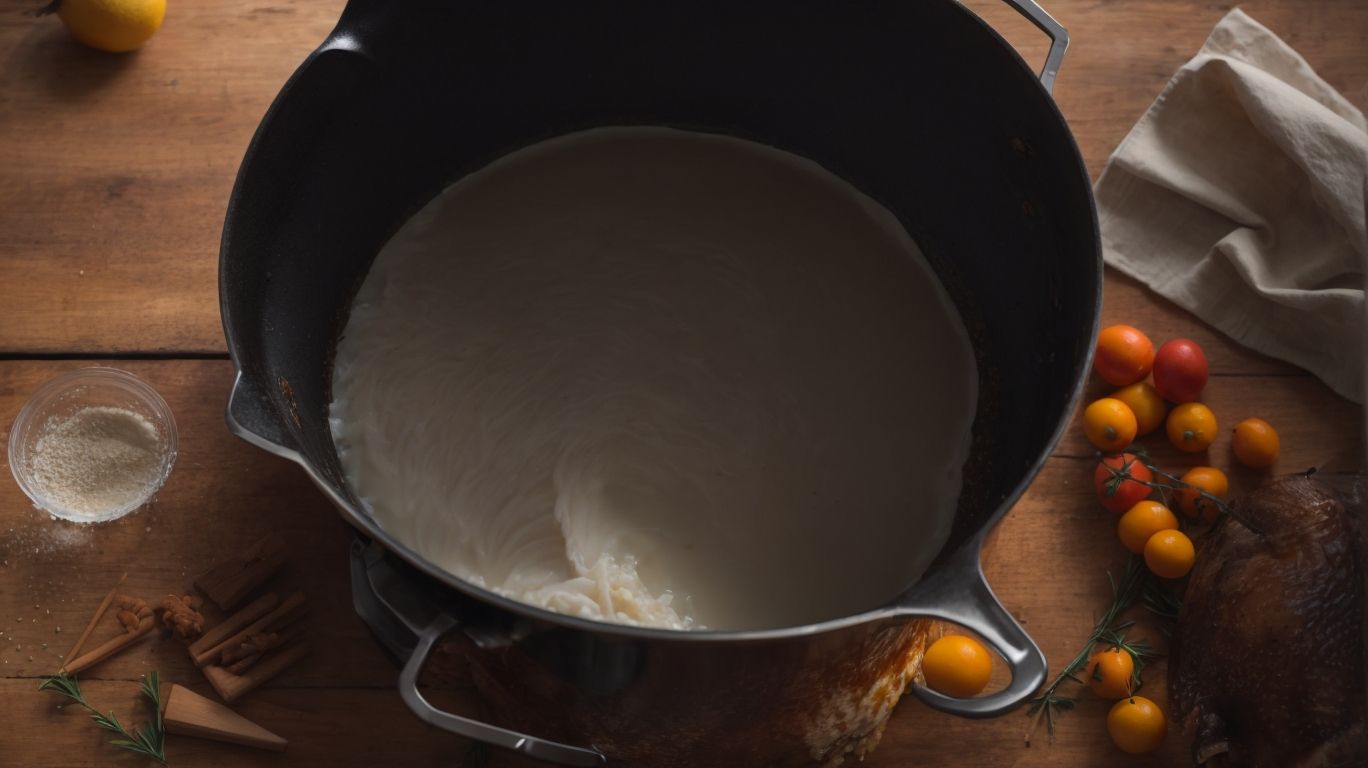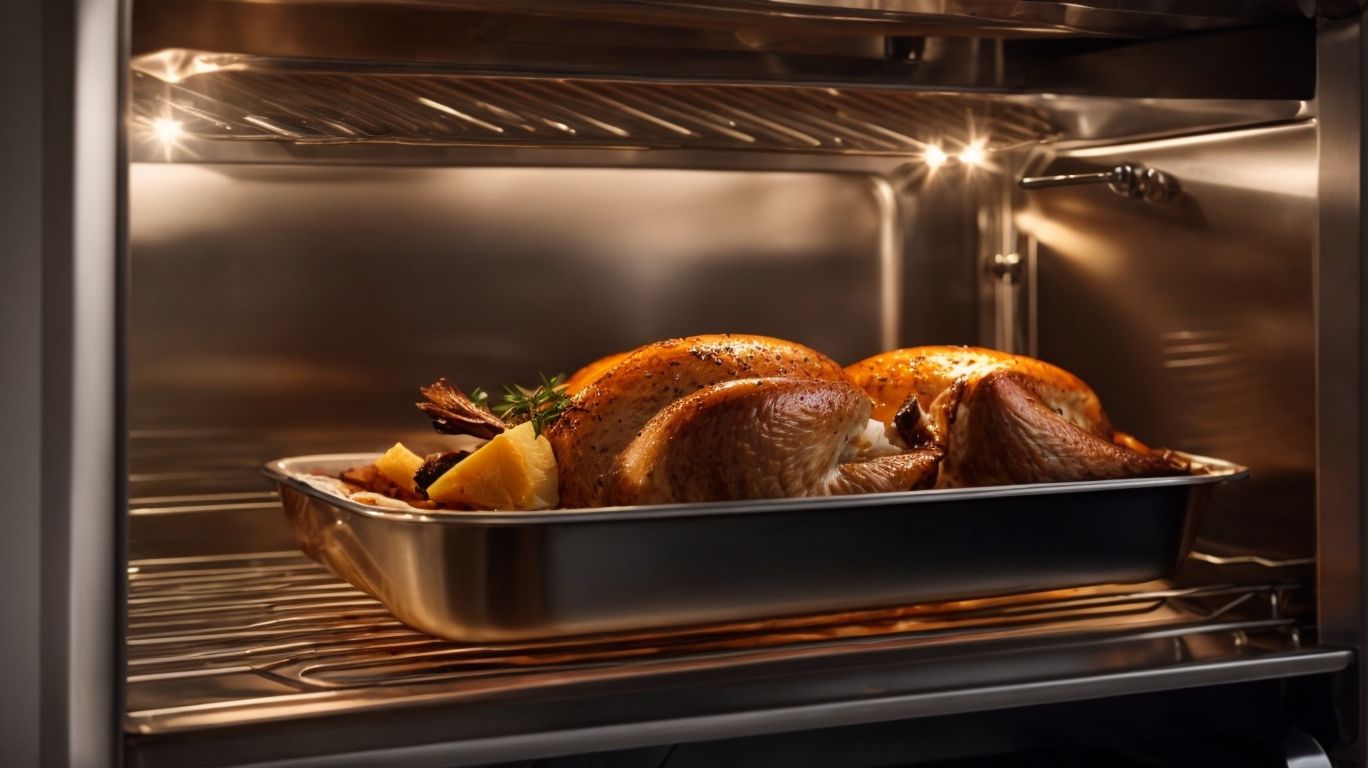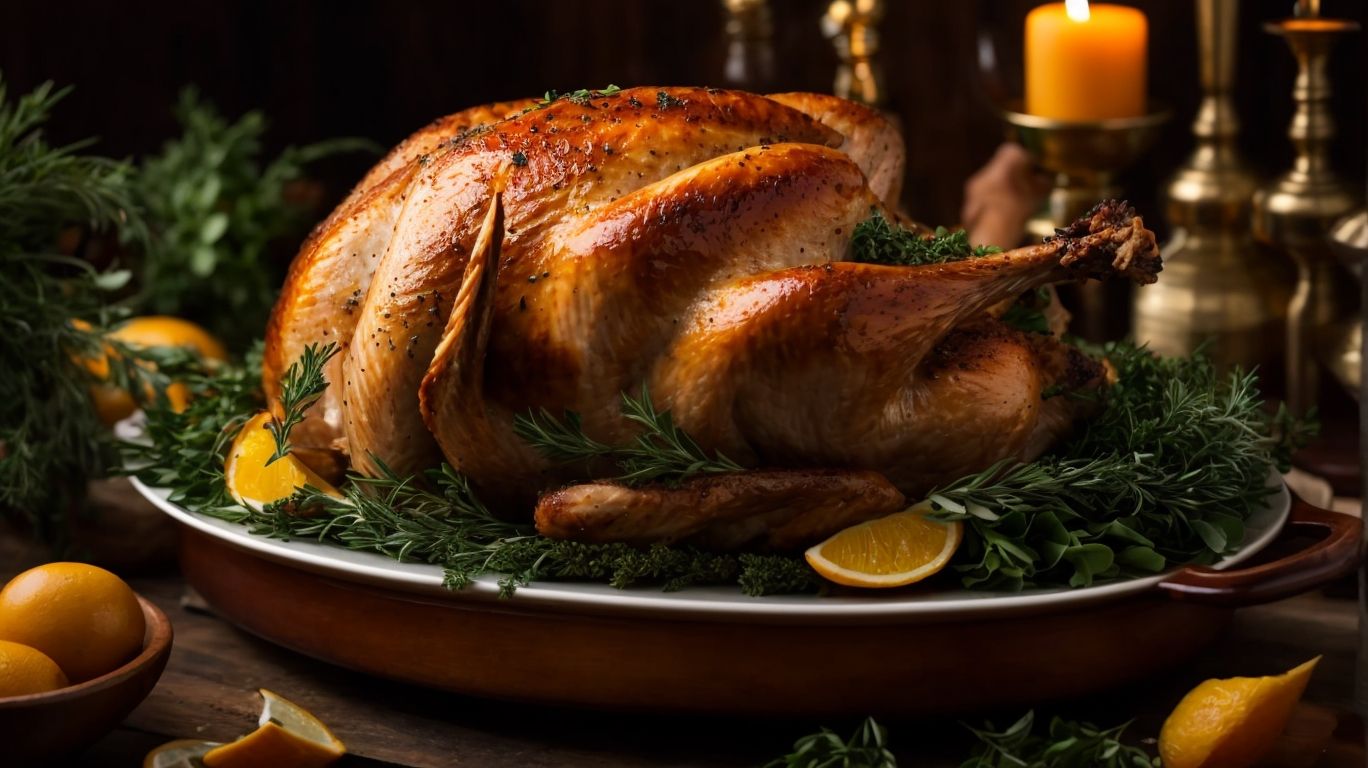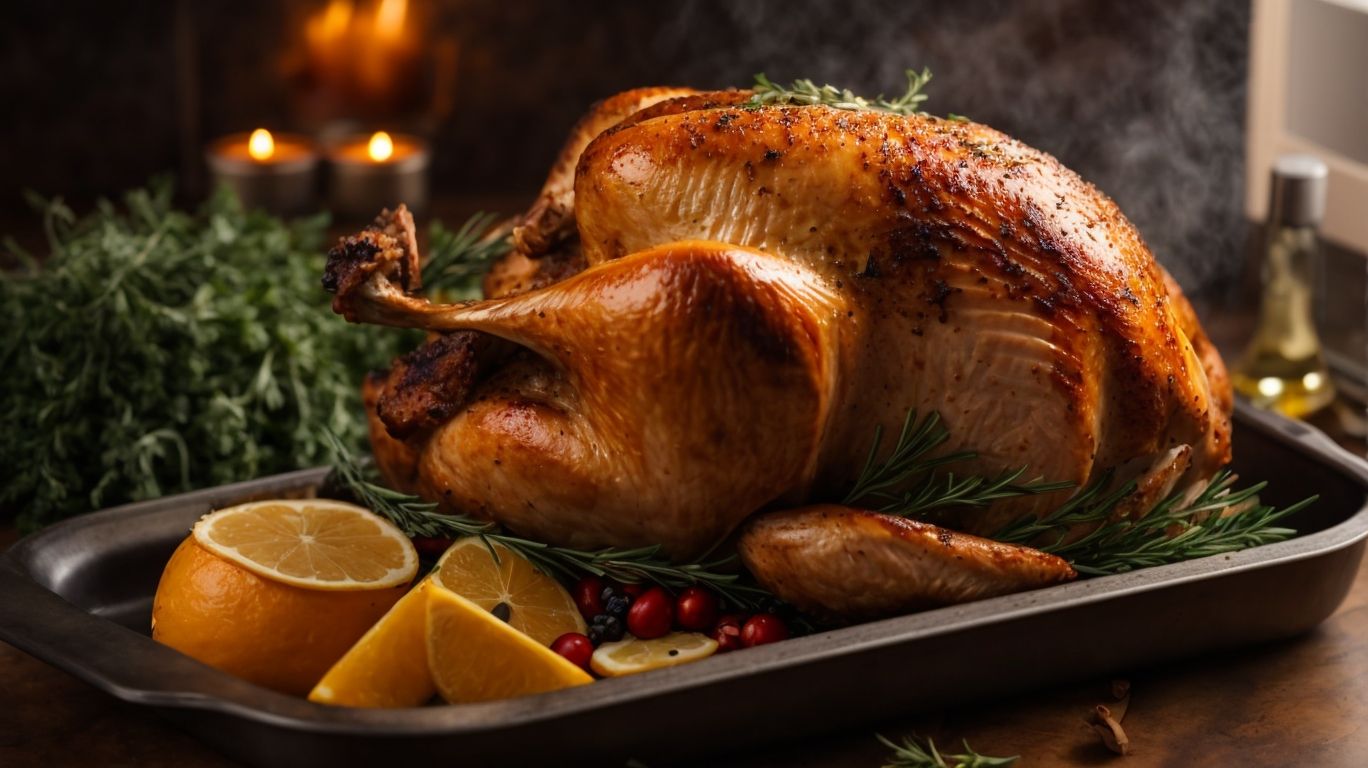How to Bake a Turkey After Brining?
Looking to elevate your turkey game this holiday season?
Explore the art of brining and how it can take your turkey to the next level. Learn about the benefits of brining and follow step-by-step instructions on how to brine a turkey.
Discover how to bake a turkey after brining, with tips on keeping it moist and perfectly cooked.
Get ready to impress your guests with a delicious and juicy brined turkey!
Key Takeaways:
What is Brining and How Does it Work?
Brining is a culinary technique that involves soaking meat, such as turkey, in a solution of salt and water to enhance its flavor and moisture content. The process of brining works by allowing the salt solution to be absorbed into the meat, resulting in a juicier and more flavorful final product.
When you immerse the turkey in a brining solution, the salt within the liquid begins to penetrate the meat through osmosis, which alters the protein structure, enabling it to retain more moisture during the cooking process. This improved moisture retention leads to a tender and succulent turkey. Not only does brining enhance the texture of the meat, but also enriches its flavor profile by infusing it with the seasoned liquid.
What Are the Benefits of Brining a Turkey?
Brining a turkey offers several benefits, including making the meat more flavorful, moist, and juicy. The process of brining helps to infuse the turkey with additional flavors and ensures that it remains succulent throughout the cooking process.
One of the key advantages of brining a turkey is enhancing flavor. The salt solution used in brining penetrates the meat, resulting in a more flavorful and seasoned bird. Brining helps retain moisture by preventing the meat from drying out during cooking, leading to a juicier end product that is a delight to bite into. Alton Brown, a renowned culinary expert, recommends brining as a crucial step for achieving a perfectly cooked turkey.
How to Brine a Turkey

Credits: Poormet.Com – Richard Nguyen
Brining a turkey involves preparing a saltwater solution with fresh herbs, submerging the turkey in the brine, and refrigerating it for a specified period. Alton Brown’s brining recipe emphasizes the use of fresh herbs to enhance the turkey’s flavor profile.
When following Alton Brown’s recipe, it is crucial to select a variety of fresh herbs like rosemary, thyme, and sage to infuse the brine with rich aromatic flavors. These herbs not only add complexity to the turkey but also contribute to a more nuanced taste.
The ideal brining time for a turkey is typically around 12-24 hours, and maintaining a refrigeration temperature of below 40°F (4°C) is essential to prevent bacterial growth while allowing the flavors to permeate the meat perfectly.
What Ingredients Do You Need for Brining?
To prepare a brine for the turkey, you will need ingredients such as kosher salt, sugar, and a variety of fresh herbs. These components form the base of the brine solution that will enhance the flavor and moisture of the turkey.
For a standard-sized turkey, you would typically require around 1 cup of kosher salt to help infuse the meat with flavor and retain moisture during the cooking process. Alongside the salt, adding about 1/2 cup of sugar can balance out the savory notes, providing a hint of sweetness to contrast the saltiness.
In terms of fresh herbs, a combination of rosemary, thyme, and sage works wonders by imparting aromatic undertones and earthy flavors to the turkey. These herbs not only add complexity to the brine but also penetrate the meat, creating a harmonious blend of tastes.
What Are the Steps for Brining a Turkey?
The process of brining a turkey involves submerging the bird in a saltwater solution for several hours to allow the flavors to penetrate the meat. Alton Brown’s recommended method includes using a large container filled with the brine mixture and refrigerating the turkey for the specified duration.
When preparing the brine mixture, it’s crucial to maintain the right water-to-salt ratio. Brown suggests a mixture of 1 cup of salt to 1 gallon of water. This ratio is essential for ensuring that the turkey absorbs the optimal amount of flavor and moisture during the brining process.
How to Bake a Turkey After Brining

Credits: Poormet.Com – Harold Scott
After brining the turkey, the next step is to bake it in the oven to achieve a beautifully browned and flavorful roast. Using a combination of butter and Alton Brown’s roasting techniques will result in a delicious and moist turkey that’s perfect for any occasion.
Once the turkey has been brined, remove it from the brining liquid and pat it dry with paper towels. Preheat the oven to the appropriate temperature, typically around 325°F (165°C).
Prepare a roasting pan by placing a rack inside. Rub the turkey all over with softened butter; this will help create that golden-brown, crispy skin that everyone loves. Make sure to tuck the wing tips under the body and tie the legs together with kitchen twine to ensure even cooking.
Follow Alton Brown’s advice by starting the roasting process with the turkey breast-side down. This technique helps to keep the breast meat moist during the initial cooking stage. After a while, carefully flip the turkey over to finish roasting breast-side up, allowing the skin to crisp up and turn that perfect shade of golden brown.
What Ingredients Do You Need for Baking a Brined Turkey?
For baking a brined turkey, essential ingredients include the turkey itself, butter for basting, a selection of herbs for seasoning, and a reliable thermometer to monitor the internal temperature. These components are crucial for achieving a perfectly baked and flavorful turkey.
Butter plays a vital role in keeping the turkey moist and adding richness to the overall flavor profile. It helps in achieving that golden, crispy skin that everyone loves.
The selection of herbs is where customization comes into play, enhancing the aroma and taste of the turkey. Combining herbs like rosemary, thyme, and sage can elevate the dish to a whole new level.
Monitoring the internal temperature ensures that the turkey is cooked through but remains juicy, preventing it from drying out and becoming tough.
What Are the Steps for Baking a Brined Turkey?
Baking a brined turkey involves preheating the oven to the recommended temperature, placing the turkey in a roasting pan, and cooking it for the specified time. Ensuring that the oven temperature is accurate and allowing the turkey to rest post-baking are crucial steps for a successful outcome.
Once the turkey has been removed from the oven, tent it loosely with aluminum foil and let it rest for around 20-30 minutes before carving. This resting period allows the juices to redistribute, resulting in a moist and flavorful bird.
To achieve a crispy skin, you can start roasting the turkey at a higher temperature (around 425°F) for the first 30 minutes, and then reduce the heat to around 325°F for the remaining cooking time. This technique helps in browning the skin while keeping the meat juicy.
For additional flavor, consider placing aromatics like herbs, garlic, onions, or citrus inside the cavity of the turkey before roasting. These ingredients infuse the meat with delightful flavors during the cooking process.
Tips for a Perfectly Baked Brined Turkey

Credits: Poormet.Com – Jose Green
To ensure a perfectly baked brined turkey, it’s essential to monitor the oven temperature accurately, baste the turkey with butter for added moisture, and follow Alton Brown’s tips for achieving a crispy skin. Paying attention to these details will result in a delectable and succulent turkey.
When preparing your brined turkey, remember that the temperature control is crucial – start roasting at a higher temperature for a crispy exterior, then reduce it to cook the meat evenly. To ensure moisture retention, consider tenting the turkey with foil during cooking and using a meat thermometer to check for doneness. Alton Brown advises spatchcocking the turkey for faster and more even cooking, and using a flavorful dry rub to enhance the taste profile.
How Long Should You Bake a Brined Turkey?
The ideal baking time for a brined turkey varies based on its weight and the oven temperature used. A general guideline is to calculate approximately how many hours per pound are needed for roasting. Ensure to check the turkey’s internal temperature with a thermometer to confirm doneness, and utilize the drippings for gravy preparation.
Factors such as the size of the turkey play a vital role in determining the cooking time. Larger birds require more time in the oven, while smaller ones cook quicker. The oven temperature significantly affects the overall baking duration. It’s recommended to preheat the oven adequately and maintain a consistent heat throughout the cooking process.
Alton Brown, a renowned chef, emphasizes the importance of using a meat thermometer to achieve perfection in turkey roasting. By inserting the thermometer into the thickest part of the bird, you can ensure that it reaches the safe internal temperature, typically 165°F (74°C).
What Temperature Should the Oven Be Set to?
The oven temperature for baking a brined turkey typically ranges between 325-350 degrees Fahrenheit, depending on the recipe and desired cooking method. Maintaining a consistent oven temperature throughout the cooking process is essential for achieving evenly cooked and flavorful turkey meat.
Alton Brown, the renowned chef and food expert, advises adjusting the oven temperature based on the texture and doneness you desire. For a juicy and tender turkey, aim for a lower temperature around 325°F to slowly cook the bird without drying it out. If you prefer a crispier skin and faster cooking time, consider a higher temperature closer to 350°F.
How to Tell When the Turkey is Fully Cooked?
Determining the readiness of a turkey involves using a meat thermometer to check the internal temperature of the thigh meat, which should reach a minimum of 165 degrees Fahrenheit for safe consumption. Allowing the turkey to rest after baking is crucial to redistribute the juices and ensure a moist final product.
Alton Brown, a renowned culinary expert, stresses that achieving the perfect internal temperature is the hallmark of a well-cooked turkey. To accurately measure this, insert the thermometer into the thickest part of the thigh without touching the bone. Once the thermometer reads 165 degrees Fahrenheit or above, the turkey is safe to eat.
The resting period is equally important as the cooking process itself. During this phase, the residual heat continues to cook the bird gently while the juices, which have been driven to the center by the heat, redistribute throughout the meat. This results in a tender, succulent turkey that captures the essence of the flavors.
How to Keep the Turkey Moist During Baking?
Maintaining the moisture of the turkey while baking can be achieved by basting the bird with butter periodically, covering it with foil to prevent excessive drying, and utilizing the drippings to enhance flavor. These techniques help ensure that the turkey remains juicy and succulent throughout the cooking process.
In terms of basting with butter, Alton Brown recommends starting with softened butter mixed with your favorite herbs and spices for added flavor. This mixture not only helps keep the meat moist but also adds a delicious aroma.
Additionally,
- tenting the turkey with foil during the first few hours of roasting can shield it from direct heat, allowing the meat to cook evenly without losing moisture.
Remember to remove the foil in the final stages to achieve that desired golden brown skin. Utilizing the drippings as a base for gravy is another pro tip from Brown, ensuring a rich and flavorful accompaniment to your perfectly moist turkey.
Conclusion and Final Thoughts
Brining and baking a turkey can elevate your holiday meal to new heights, infusing the meat with exceptional flavor and moisture. Following Alton Brown’s expert guidance on brining and roasting techniques promises a delectable and unforgettable dining experience.
By immersing the turkey in a specially crafted brine solution, you allow the flavors to permeate the meat, resulting in a juicy and flavorful centerpiece for your feast. The process of brining works wonders by tenderizing the turkey and locking in its natural juices, creating a succulent end product that is bound to impress your guests.
Frequently Asked Questions
What is brining and why is it important for cooking a turkey?
Brining is a process of soaking meat in a saltwater solution to enhance its flavor and retain moisture during cooking. Brining also helps to tenderize the meat, making it juicier and more flavorful.
How long should I brine my turkey before baking it?
The recommended brining time for a turkey is about 12-24 hours, depending on the size of the bird. It’s important not to over-brine, as this can result in a salty and over-seasoned turkey.
Can I use a pre-brined turkey for this recipe?
Yes, you can use a pre-brined turkey for this recipe. Just be sure to rinse off the excess brine before baking, as the pre-brined turkey may already have a high salt content.
What ingredients do I need for the brine mixture?
For a basic brine, you will need water, salt, sugar, and any additional herbs or spices of your choice. You can also add apple cider, beer, or other liquids to enhance the flavor of your brine.
Do I need to dry off the turkey after brining before baking?
It is recommended to pat the turkey dry with paper towels before baking. This will help the skin to crisp up and prevent the turkey from being too watery.
Can I stuff the turkey with stuffing after brining?
No, it is not safe to stuff a turkey with stuffing after brining. The brine solution may have soaked into the stuffing, making it too salty and potentially harmful if not cooked properly. It is best to cook the stuffing separately.

